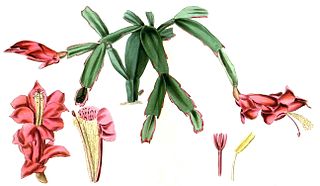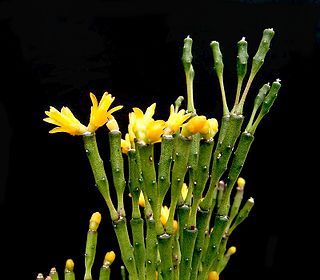
A cactus is a member of the plant family Cactaceae, a family comprising about 127 genera with some 1,750 known species of the order Caryophyllales. The word cactus derives, through Latin, from the Ancient Greek word κάκτος (káktos), a name originally used by Theophrastus for a spiny plant whose identity is now not certain. Cacti occur in a wide range of shapes and sizes. They are native to the Americas, ranging from Patagonia in the south to parts of western Canada in the north, with the exception of Rhipsalis baccifera, which is also found in Africa and Sri Lanka. Cacti are adapted to live in very dry environments, including the Atacama Desert, one of the driest places on Earth. Because of this, cacti show many adaptations to conserve water. For example, almost all cacti are succulents, meaning they have thickened, fleshy parts adapted to store water. Unlike many other succulents, the stem is the only part of most cacti where this vital process takes place. Most species of cacti have lost true leaves, retaining only spines, which are highly modified leaves. As well as defending against herbivores, spines help prevent water loss by reducing air flow close to the cactus and providing some shade. In the absence of true leaves, cacti's enlarged stems carry out photosynthesis.

Schlumbergera truncata, the false Christmas cactus, is a species of plant in the family Cactaceae. It is endemic to a small area of the coastal mountains of south-eastern Brazil where its natural habitats are subtropical or tropical moist forests. It is the parent or one of the parents of the houseplants called Christmas cactus, Thanksgiving cactus or zygocactus, among other names.

Schlumbergera is a small genus of cacti with six to nine species found in the coastal mountains of south-eastern Brazil. These plants grow on trees or rocks in habitats that are generally shady with high humidity, and can be quite different in appearance from their desert-dwelling cousins. Most species of Schlumbergera have stems which resemble leaf-like pads joined one to the other and flowers which appear from areoles at the joints and tips of the stems. Two species have cylindrical stems more similar to other cacti.

Epiphyllum is a genus of epiphytic plants in the cactus family (Cactaceae), native to Central America and South America. Common names for these species include climbing cacti, orchid cacti and leaf cacti, though the latter also refers to the genus Pereskia.

Rhipsalis is a genus of epiphytic flowering plants in the cactus family, typically known as mistletoe cacti. They are found in parts of Central America, the Caribbean and northern regions of South America. They also inhabit isolated locations in Africa and Asia, and are the only cactus group naturally occurring in the Old World. This is the largest and most widely distributed genus of epiphytic cacti.

Hatiora is a small genus of epiphytic cacti which belongs to the tribe Rhipsalideae within the subfamily Cactoideae of the Cactaceae. Recent taxonomic studies have led to the three species formerly placed in subgenus Rhipsalidopsis being removed from the genus, including the well known and widely cultivated ornamental plants known as Easter cactus or Whitsun cactus.

Rhipsalidopsis is a small genus of flowering plant in the family Cactaceae, native to southern Brazil. Like other members of the tribe Rhipsalideae, its species are epiphytes, growing on trees.

Disocactus anguliger, commonly known as the fishbone cactus or zig zag cactus, is a cactus species native to Mexico. The species is commonly grown as an ornamental for its fragrant flowers in the fall.
Schlumbergera kautskyi is a species of plant in the family Cactaceae. It is endemic to a small area of the coastal mountains of south-eastern Brazil where its natural habitat is rocky areas. It is threatened by habitat loss. It is in the same genus as the popular houseplant known as Christmas cactus or Thanksgiving cactus.

Schlumbergera microsphaerica is a species of plant in the family Cactaceae. It is endemic to a limited area of the coastal mountains of south-eastern Brazil where its natural habitat is rocky areas above 2,600 m (8,500 ft). It is threatened by habitat loss. It is in the same genus as the popular house plant known as Christmas cactus or Thanksgiving cactus.

Schlumbergera opuntioides is a species of plant in the family Cactaceae. It is endemic to the coastal mountains of south-eastern Brazil where its natural habitats are humid forests and rocky areas. It is threatened by habitat loss. It is in the same genus as the popular house plant known as Christmas Cactus or Thanksgiving Cactus.
Schlumbergera orssichiana is a species of plant in the family Cactaceae. It is endemic to a small area of the coastal mountains of south-eastern Brazil where its natural habitat is moist forest. It grows on trees as an epiphyte. It is in the same genus as the popular houseplant known as Christmas cactus or Thanksgiving cactus.

Schlumbergera russelliana is a species of plant in the family Cactaceae. It is endemic to a small area of the coastal mountains of south-eastern Brazil where its natural habitat is moist forest. It grows on trees as an epiphyte. It is one of the parents of many of the popular houseplants known as Christmas cactus or Thanksgiving cactus.

The Rhipsalideae are a small tribe of cacti, comprising four or five genera. They grow on trees (epiphytes) or on rocks (lithophytes), where they either hang down or form creeping or upright shrubs. Their flowers open in the day and remain open at night; they may be either radially symmetrical (regular) or bilaterally symmetrical (zygomorphic). The fruits are berry-like, fleshy with smallish seeds.

Epiphyllum hybrids, epiphyllums, epicacti, or just epis, also known as orchid cacti, which are widely grown for their flowers, are artificial hybrids derived primarily from species of the genus Disocactus. These Disocactus species are not true epiphyllums, but they used to be included in the genus Epiphyllum.

Hatiora salicornioides, the bottle cactus, dancing-bones, drunkard's-dream, or spice cactus, is a species of flowering plant in the cactus family. A member of the tribe Rhipsalideae, it often grows as an epiphyte, natively in eastern Brazil and ornamentally elsewhere.

Rhipsalidopsis rosea, synonyms Hatiora rosea and Schlumbergera rosea, is a species of flowering plant in the family Cactaceae, native to south Brazil. It was first described, as Rhipsalis rosea, by Gustaf Lagerheim in 1912. It is one of the parents of the hybrid Rhipsalidopsis × graeseri, grown as the Easter or Whitsun cactus.
Schlumbergera lutea, synonym Hatiora epiphylloides, is a species of flowering plant in the family Cactaceae, subfamily Cactoideae, native to southeast Brazil. It is a shrubby epiphyte, with flattened stems and bright yellow flowers.

Hatiora cylindrica is a species of often epiphytic cactus in the tribe Rhipsalideae within the subfamily Cactoideae. It is native to east Brazil, where it grows in a variety of habitats, including moist forest, dunes and coastal rocks.
Hatiora herminiae is a species of flowering plant in the tribe Rhipsalideae, family Cactaceae. It grows as an epiphyte in cloud forests in Southeast Brazil.

















